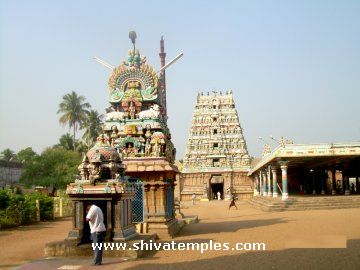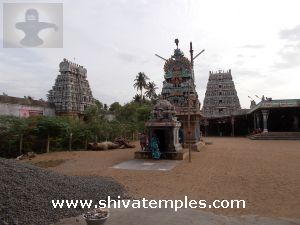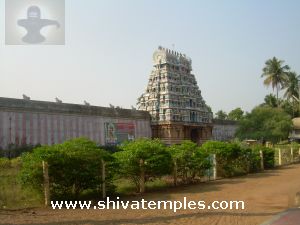Thenupureeswarar temple, Tirupatteswaram
Location: Tiru-Patteeswaram
Deity known as: Thenupureeswarar, Patteeswarar
Female Deity: Sri Gyanambikai, Sri Palvalainayagi
Pathikam: Sambandar - 1
Gallery - Tirupatteswaram Temple
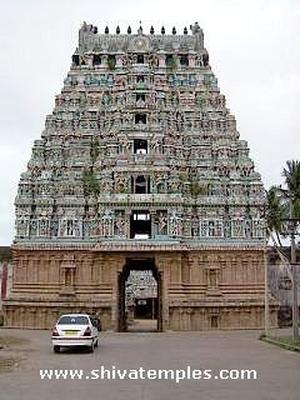
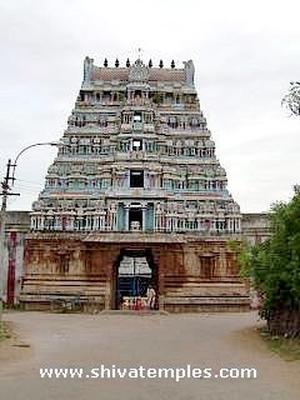
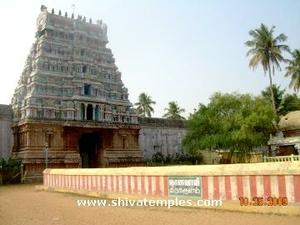
How to reach
This temple is located at about 9 Kms south-west of Kumbakonam and about 3 Kms south-east of Swamimalai. Bus facilities are available from Kumbakonam and Thanjavur. The temple is very near to Tiru-Shakthi-Muththam, another Paadal Petra Sthalam.
Temple Address
Patteeswaram Village
Kumbakonam Taluk
Thanjavur District
Tamil Nadu, India
PIN - 612703
Temple hours
Morning: 6:00 - 12:30
Evening: 4:00 - 9:00
Nearby Paadal Petra Sivasthalams
| 1 | Tiru-Shakthi-Muththam – 1.2 km | |
| 2 | Tiru-Valanchuzhi – 3.5 km | |
| 3 | Tiru-Kudamookku (Kumbakonam) – 6 km |
Sthala Purana
The celestial cow Kamadhenu's daughter, Patti, worshipped the deity in this sacred place; hence the site came to be known as Patteeswaram. It also holds special significance as Goddess Parashakti chose this very place to perform penance. Pleased with Her devotion, Shiva appeared before Her with His matted locks.
Here, Sage Viswamitra attained the supreme knowledge of the Gayatri Mantra and was conferred the exalted title of Brahmarishi. When Rama incurred the sāyahatthi dosha (the blemish of killing Vali), He created a sacred well called Koditheertham by striking the ground with the tip of His bow. Using its holy waters, He performed abhishekam to a shiva linga and was freed from the sin. The Shiva Linga which was worshipped by Rama here is venerated as Ramalingam.
A Brahmin named Dharmasharma, from the land of Malava, was once cursed by Sage Medhavi and transformed into a dog. His curse was lifted when a single drop of water from the sacred Gnanavavi Theertham (holy pond within this temple) touched him.
Temple Architecture
The Shiva temple in this sacred place, located on the northern bank of the Thirumalarayan River, measures 650 feet in length from east to west and 295 feet from south to north. It has five tall and majestic gopurams (towering gateways) and three prakarams (enclosures). The main gopuram rises to seven tiers, while the other gopurams have five tiers each.
Main Sanctum - Moolavar
In the first prakaram (inner courtyard) of the temple, at the central hall, lies the sanctum of the presiding deity, Patteeswarar. Outside is the sannidhi of Somasakandhar, and around are sannidhis dedicated to the Sapta Kanyas, Maha Lingam, Rama Lingam, Lakshmi, Chandikeswarar, Nataraja, Surya (Sun God), Renukadevi, Suvarna Vinayaka (Golden Ganesha), and the Navagrahas (Nine Planets).
Goddess Gyanambikai
On the northern side is the sannidhi of Goddess Gnanambikai. The hall in front of the goddess's sannidhi is rich in artistic features. The yalis (mythical lion-like creatures) carved on the pillars of this mandapam are each sculpted in unique designs. At the center of the hall, a stone chain hangs from the ceiling, carved entirely out of a single block of stone. A stone wheel, also hewn from a single piece, is ingeniously crafted to revolve.
Five Nandis - A Unique Feature
This temple is unique in having five Nandis (sacred bull idols), all of which are placed unaligned with the sanctum. When Tirugnanasambandar came to Patteeswaram at noon, after worshipping at Thiruvalanchuzhi, Pazhayarai Metrali, and Thirucchathimurram, the scorching sun was intense. To shield him from the heat, Shiva commanded His divine attendants 'Bhootha Ganas' to form a pearl canopy (muthu pandal) above him, so that he could walk in its shade. To ensure that Nandi did not obstruct Sambandar's vision of the deity while he came for darshan, Patteeswarar graciously ordered that all the Nandis stand aside—a distinctive glory of this temple.
Patteeswaram Durga
In the outer prakaram, at the northern gopuram entrance, stands the shrine of Goddess Durga. The Durga at the northern gateway of the Patteeswaram temple is considered to be especially powerful. During the Chola period, a palace was situated at Pazhayarai for the residence of the royal women. At the northern entrance of that palace fort resided this very Durga.
Though this is a Shiva temple with an interesting history, the most famous deity in this temple is Durga. Patteeswaram Durga is said to be a very powerful deity, and draws devotees from all over. She is basically a Kaaval deivam (or a guardian deity) of this temple, and has her sanctum right at the entrance. Though Durga is generally considered an angry deity, in this temple, the black granite idol of the goddess with her vehicle the lion, eight arms holding different weapons, killing the demon Mahishasura, has a smiling visage, which seems to reassure us.
Devotees consider it especially auspicious to worship here during Rahu Kalam, on Tuesdays, Fridays, and Sundays, as well as on Amavasya (new moon days), Pournami (full moon days), and on the Ashtami and Navami tithis. At this shrine, Durga manifests in a calm and benevolent form, blessing devotees with compassion through her eight divine hands.
Temple Festivals
Visaka Festival
On the day of Visaka star in the Tamil month of Vaikasi, the Panchamurthis (five deities) are taken out in a grand procession on their vahanas to the Thirumalarajan River. In the evening, the deities return in their vimanas, giving darshan to devotees, and re-enter the temple.
Muthu Pandal Festival
On the first day of the Tamil month of Aani, a special festival is celebrated in commemoration of Shiva commanding His attendants to form a pearl canopy (muthu pandal) for Saint Tirugnanasambandar. This is regarded as the most significant festival of this temple.
Margazhi Festival
On the new moon day of the Tamil month of Margazhi, the Panchamurthis are taken out in procession on various vahanas, circumambulating the streets and converging at the Kodi Theertham. This festival is observed in connection with the legend of Lord Rama being absolved of the sāyahatthi dosha here.
Sambandar's Pathigam
The pathigam (decade of hymns) composed by Tirugnanasambandar for this shrine is included in the Third Thirumurai. In the first verse of this hymn, he indicates that in ancient times this location was known by the name Mazhapadi.
In this hymn, Sambandar describes the deity of this temple as residing at Thiruppatteeswaram, situated within the city of Thirumazhapadi, a town adorned with mansions, surrounded by shady groves, in the region of Thiruppazhayarai.
More Gallery Images
